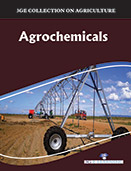Agriculture and Life Sciences

Crop protection chemistry has come a long way from its “alchemic” beginnings in the late 19th century to a high-tech science that supports the sustainable production of food, feed, and fiber for a rapidly growing population. The role of pesticides has become critically important with modernization of agriculture. Modernization of agriculture implies increased use of modem inputs such as chemical fertilizer, irrigation and modern seeds, which provide a favorable climate for rapid growth of pests. Moreover, modern seeds are more susceptible to insect pests and diseases. Because of their huge market in all continents, agrochemicals are among the most common pollutants in one fifth of the Earth’s land. Also, given the high toxicity of most insecticides, herbicides and fungicides to their target and nontarget organisms, their negative impacts on the environment cannot and must not be ignored. Indeed, pesticides constitute one of the main drivers of population decline in some wildlife species. Therefore, proper understanding of the risk that pesticides and other agrochemicals pose to organisms and ecosystems is essential.
Innovative developments in the design and synthesis of agrochemicals assist to deal today’s challenges of weed and pest resistance, advanced regulatory safety margins, and higher cost of goods with the invention of selective, environmentally benign, low use rate, and cost-effective active ingredients.
This book entitled “Agrochemicals” brings together up-to-date knowledge and perspectives on all aspects of the use of chemicals and biotechnology in agriculture. It provides insights into the difficulties and challenges of performing risk evaluations of agrochemicals as the massive quantity of chemical contaminants that are currently found in air, soil, water and sediments of our planet, frequently as a result of human activities.
Chemicals are used in every facet of life and are present in a bewildering range of products and applications. Growing knowledge of the wide distribution and impact of chemicals in the environment and the human body has underscored the need for their regulatory control and careful management. Agricultural pesticides are an important subset of chemicals and pose specific challenges. The use of pesticides, however, carries several dangers. Non-optimal and non judicious use of pesticides may result in a series of problems related to both loss of their effectiveness in the long run and certain externalities like pollution and health hazards. It is argued that increase in production cost, when associated health costs are counted due to use of pesticides, exceeds the improvement in crop productivity. Prophylactic chemical control recommendations for rice were set in the early 70s when modern varieties were introduced. Since then, despite improved varietal resistance and management practices, these recommendations have hardly changed. Prophylactic chemical control has been associated with destruction of other beneficial species, resurgence of the treated pest populations, outbreaks of secondary pests, residues in food, feed and the environment, and farmer illness from prolonged exposure to pesticides. Since pesticides having some undesirable effect on environment and human health, several countries are introducing integrated pest management (IPM) technologies which are based on the natural balancing forces in ecological system. An economic evaluation of these technologies is urgently needed. The book also aims to provide an overview of toxicology that examines the hazardous effects of common agrochemicals employed every day in our agricultural practices. Furthermore, it is hoped that the information in the present book will be of value to those directly engaged in the handling and use of agrochemicals and that this book will continue to meet the expectations and needs of all interested in the different aspects of human and environmental risk toxicities.